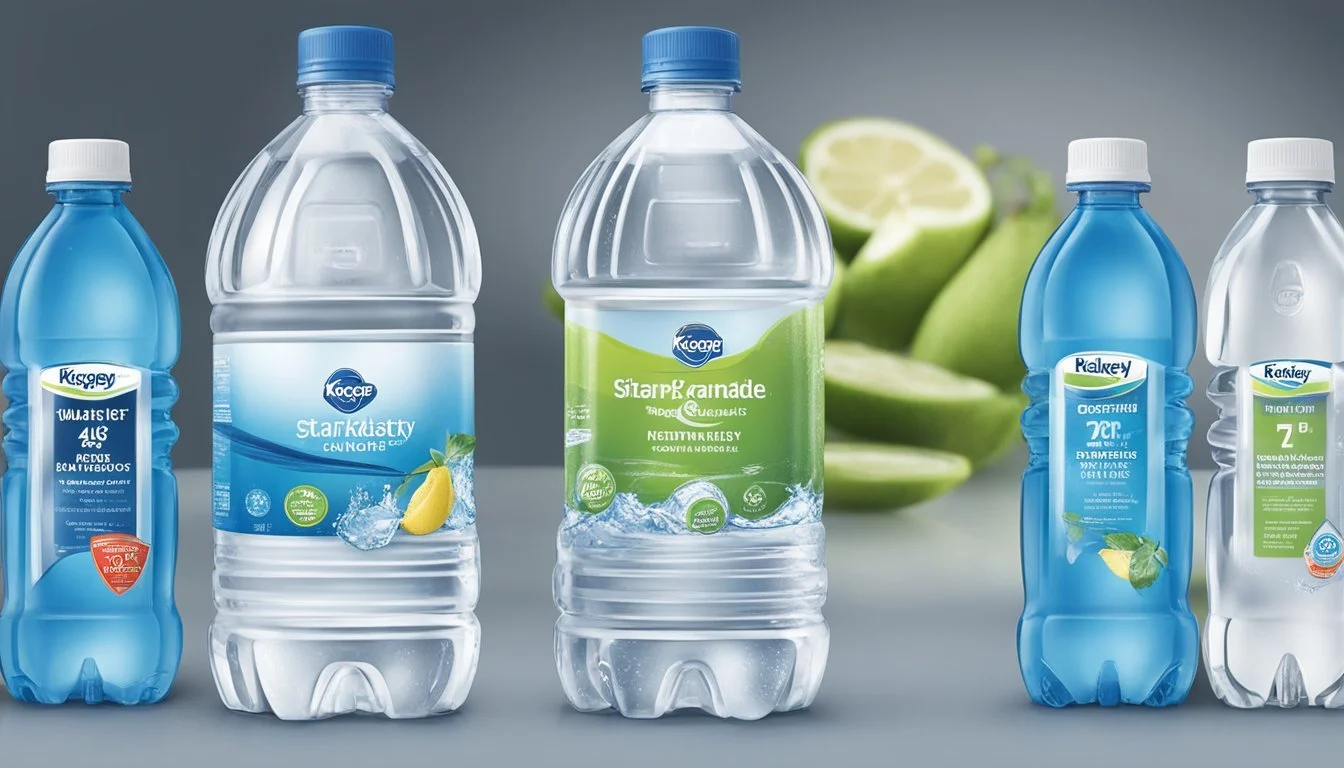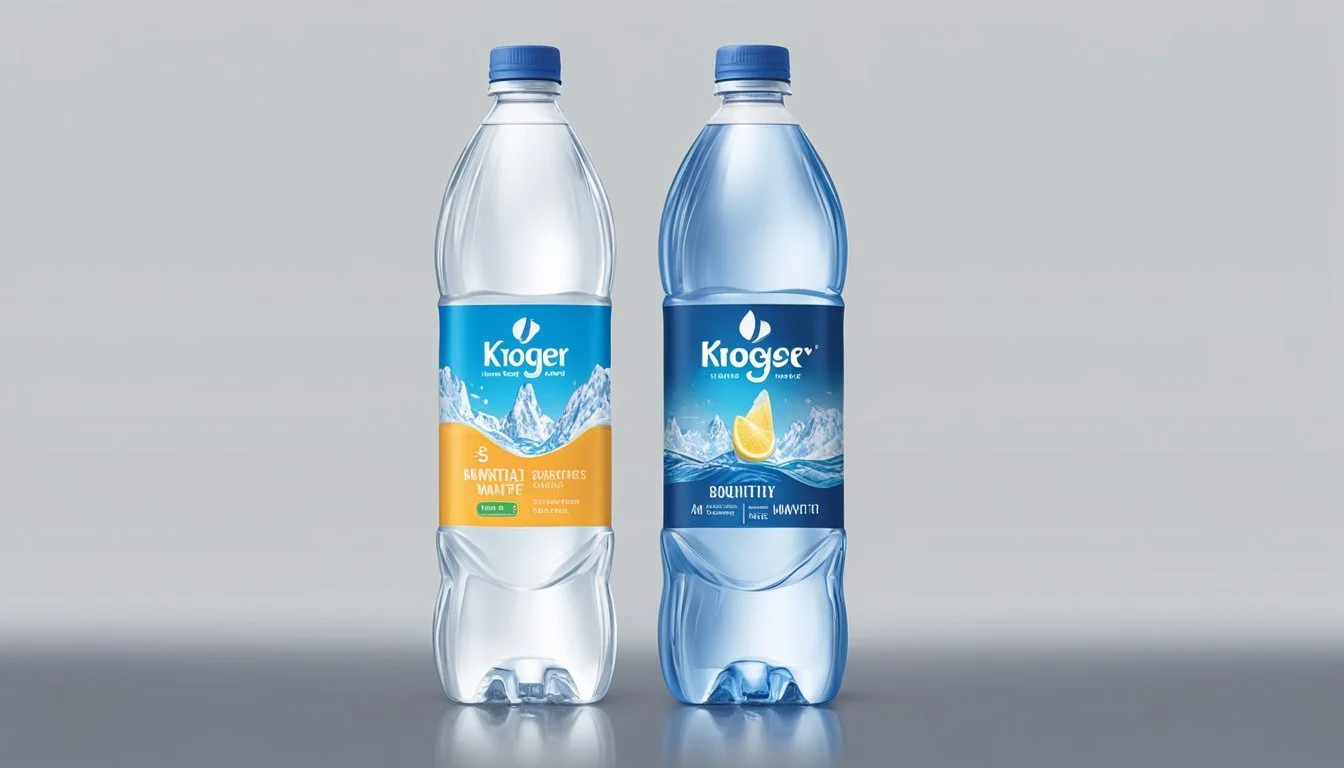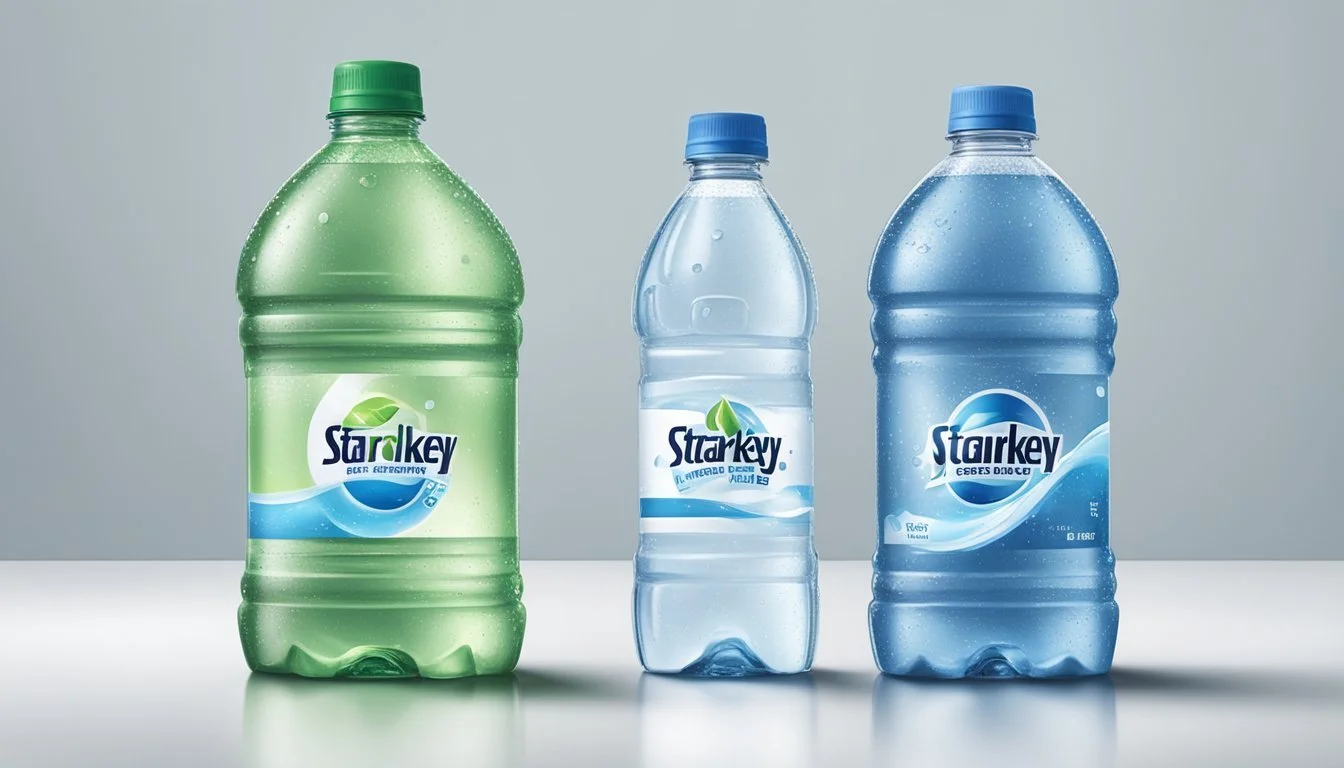Starkey vs. Kroger
Which Bottled Water is Better? A Comprehensive Comparison
Choosing the best bottled water can be daunting with so many brands to consider. When it comes to Starkey and Kroger bottled waters, a direct comparison reveals notable differences. Starkey offers a premium, naturally sourced option that boasts a clean, crisp taste.
On the other hand, Kroger provides a more budget-friendly choice that ensures solid hydration without breaking the bank. For those who prioritize taste and quality over price, Starkey stands out as the preferred option. Meanwhile, Kroger is ideal for cost-conscious consumers still seeking reliable bottled water.
Ultimately, Starkey edges out Kroger with its refined purity and superior taste. However, both brands serve distinct needs within the bottled water market. Understanding these differences helps consumers make informed decisions based on their specific preferences and requirements.
Understanding Bottled Water
Choosing the right bottled water involves knowing the essentials of hydration, the distinctions between bottled and tap water, the various types available, and the meaning behind different labels like purified, natural spring, and mineral water.
The Essentials of Hydration
Hydration is crucial for maintaining bodily functions such as temperature regulation, nutrient transport, and waste removal. Adults generally need about 2-3 liters of water daily, though individual requirements may vary. For effective hydration, it’s important to drink throughout the day rather than consuming large amounts infrequently. Both bottled and tap water can meet these needs, but quality and taste may influence personal preference.
Bottled Water vs. Tap Water
Bottled water offers convenience and can be more reliable in areas with questionable tap water quality. Tap water is usually cheaper and subject to strict regulations by agencies like the EPA. Key differences include:
Cost: Bottled water tends to be more expensive.
Taste: This can vary widely between both options.
Regulation: Both are regulated but by different standards and agencies.
Types of Bottled Water
Bottled water comes in several forms, each with unique characteristics:
Purified Water: This water has been processed to remove impurities and contaminants. Methods include distillation, reverse osmosis, and deionization.
Natural Spring Water: Originates from an underground formation and flows naturally to the surface. It must be collected at the spring or through a borehole tapping the underground source.
Mineral Water: Contains specific amounts of minerals and trace elements sourced from a mineral spring. The mineral content must remain constant and meet regulatory standards.
Understanding Labels: Purified, Natural Spring, and Mineral Water
Labels on bottled water can be confusing. Here’s a breakdown:
Purified Water: Almost all impurities are removed, making it very pure but possibly lacking in minerals that contribute to taste.
Natural Spring Water: Identified by its source, natural spring water retains its mineral content, which can add beneficial nutrients and improve taste.
Mineral Water: Defined by its higher mineral content, usually above 250 ppm of total dissolved solids, which must stay consistent without additional processing to alter its content.
Understanding the distinctions between these types helps consumers make informed choices about their hydration sources.
Health and Safety Standards
When comparing Starkey and Kroger bottled water, the health and safety standards are critical. This section will cover regulatory requirements, potential contaminants, and the importance of filtration and purification.
EPA and FDA Regulations
Bottled water in the United States is regulated by the Food and Drug Administration (FDA), whereas tap water falls under the Environmental Protection Agency (EPA). The FDA sets strict standards for bottled water, equivalent to the EPA's guidelines for tap water. Both Starkey and Kroger must comply with these regulations to ensure their products meet safety and quality standards.
FDA regulations include monitoring for contaminants, setting limits for permissible levels, and enforcing proper labeling practices. Compliance with these standards guarantees that the bottled water is free from harmful bacteria, viruses, and chemicals.
Contaminants and Water Safety
Although standards are in place, concerns about contaminants still arise. Substances like microplastics, BPA, and chemicals such as PFAS have been found in various bottled waters. In tests, some brands showed trace amounts of these contaminants, despite claims of safety and compliance.
Kroger bottled water meets FDA regulations, yet tests occasionally reveal the presence of microplastics and PFAS. Starkey, too, adheres to required standards but may not be entirely free from these contaminants. Shoppers should consider these issues when deciding which brand to purchase.
The Role of Filtration and Purification
Filtration and purification are vital to ensuring bottled water safety. Both Starkey and Kroger use advanced techniques to remove impurities and contaminants from their water. Methods like reverse osmosis, activated carbon filtration, and UV light treatment are commonly employed.
Starkey prides itself on sourcing water from natural springs and utilizing rigorous filtration processes to maintain purity. Kroger, on the other hand, emphasizes a multi-step purification process to ensure consumer safety. Understanding these methods provides insight into the quality control efforts behind each brand.
Tables or lists detailing filtration methods, regulatory standards, and potential contaminants can help highlight the key differences and similarities between these two brands. This objective, straightforward analysis aims to assist consumers in making informed choices about their bottled water options.
Comparing Brand Qualities
When comparing Starkey and Kroger bottled waters, it's crucial to evaluate their taste profiles, quality testing procedures, and the significance of their water sources. Each aspect plays a vital role in determining the best choice.
Taste Profiles of Popular Brands
Taste is subjective, but there are common descriptors used to evaluate bottled water. Starkey water is often touted for its smooth and crisp taste, attributed to its alkaline properties with a pH of 9.6.
Kroger's bottled water, typically falling under the purified category, may have a more neutral taste. Some consumers note a slight chlorinated aftertaste, which can detract from its overall appeal.
Comparative Taste Profiles:
Starkey: Smooth, crisp, slightly alkaline.
Kroger: Neutral, slight chlorinated aftertaste.
Assessing Quality Through Testing
Quality testing is essential to ensure the safety and purity of bottled water. Starkey water undergoes rigorous testing and is often praised in quality reports for its minimal contaminants and adherence to strict regulatory standards.
Kroger's water also meets safety standards, but it has faced some scrutiny regarding its purification process. Regular testing is done, but consumer confidence may vary due to past inconsistencies in taste and reports.
Quality Insights:
Starkey: High regulatory compliance, minimal contaminants.
Kroger: Meets safety standards, mixed consumer confidence.
The Significance of the Source
The source of water is a significant factor in its overall quality. Starkey water is sourced from a geothermal spring located deep within the earth, which contributes to its natural alkalinity and mineral content. This geologic source is a unique selling point.
Kroger, on the other hand, sources its water from municipal supplies, which are then purified. This process can remove impurities but may also strip beneficial minerals, affecting the taste and perceived quality.
Source Characteristics:
Starkey: Geothermal spring, natural minerals, and alkaline properties.
Kroger: Municipal sources, purified, potential loss of minerals.
Specifics on Starkey and Kroger
Starkey and Kroger offer unique bottled water options, each presenting distinct qualities and sources. This section details their origins, quality, and water sources for an informed comparison.
Starkey: Origin and Quality Insights
Starkey water originates from a geothermal spring in Idaho. Bottled at the source, Starkey maintains its natural purity and mineral composition.
The water is known for its balanced pH level and smooth taste. Its quality is further ensured through minimal processing. Rich in silica, Starkey provides a unique drinking experience with potential health benefits linked to its natural mineral content.
Kroger: Brand Evaluation and Water Sources
Kroger bottled water is available in various types, including purified and natural spring water. The purified water undergoes rigorous filtration processes, including reverse osmosis, to remove impurities.
Its bottled water products are BPA-free, ensuring safety from potential contaminants. The natural spring water is sourced from selected springs and is ozonated for added purity. Kroger’s commitment to quality is evident through its adherence to FDA regulations, providing reliable hydration options.
Environmental Concerns and Sustainability
When comparing Starkey and Kroger bottled water, it is crucial to consider the environmental impact and sustainability practices of both brands. This includes examining their approaches to production and exploring eco-friendly alternatives they offer.
The Impact of Bottled Water Production
Bottled water production poses significant environmental challenges. Plastic bottles are often criticized for their contribution to pollution and waste. The manufacturing process is energy-intensive, and the disposal of plastic bottles leads to landfill accumulation and ocean pollution.
Kroger has faced scrutiny for its environmental footprint, despite adherence to safety regulations. Concerns such as microplastics and BPA in bottles highlight ongoing debates about the safety and ecological impact of their products.
In contrast, Starkey strives to minimize ecological damage by exploring sustainable practices, including using lighter-weight materials to reduce transportation emissions. They also aim to lower their carbon footprint by enhancing the efficiency of their production processes.
Eco-Friendly Alternatives and Innovations
Both brands are recognizing the need for environmentally friendly packaging. Kroger has introduced some BPA-free bottles and is investing in recycling initiatives to mitigate waste. Nevertheless, reliance on plastic remains a sticking point.
Starkey is exploring alternatives like glass bottles and boxed water, which are more sustainable. These options lessen the reliance on plastic, promote recycling, and degrade more naturally without harming the environment.
Innovative solutions are essential for reducing environmental impacts. Both companies are working towards more sustainable practices, but challenges persist. The push for greener alternatives is crucial for future sustainability in the bottled water industry.
Consumer Preferences and Market Trends
Consumer preferences within the bottled water market show significant shifts, including the demand for various types of water and the popularity of flavored and functional waters.
The Demand for Different Types of Water
Demand for bottled water varies as consumers prioritize health and convenience. Sparkling water has gained traction, offering a fizzy alternative to traditional still water.
Alkaline water, like Essentia and Core Hydration, attracts those looking for potential health benefits from higher pH levels. Smartwater appeals to consumers seeking vapor-distilled options with added electrolytes.
Kroger provides practical and budget-friendly bottled water, often in plastic bottles. Starkey, though lesser-known, is favored for its premium artesian water sourced from a deep geothermal spring, fulfilling a niche market for high-end water.
The Rise of Flavored and Functional Waters
Flavored and functional waters are growing rapidly in the beverage market. These waters cater to consumers looking for more than just hydration. Flavored options, often with hints of fruit or botanical essences, appeal to taste-conscious buyers. Brands like Hint and LaCroix are popular for offering a variety of flavors without added sugars or calories.
Functional waters address specific needs, such as enhanced hydration or nutritional benefits. Products may include added vitamins, minerals, or antioxidants, catering to the health-conscious market segment. This trend reflects a broader consumer shift towards personalized and purpose-driven beverage choices.
Analysis and Comparison
This section will examine the cost-efficiency and accessibility of Starkey and Kroger bottled water, followed by an in-depth look at their quality spectrum.
Cost-Efficiency and Accessibility
Starkey bottled water, available primarily at Whole Foods, tends to be pricier. Its higher cost is attributed to its source, an artisan aquifer, and premium branding. This may put it out of reach for budget-conscious consumers or those without access to Whole Foods locations.
Kroger bottled water, in contrast, is widely available at grocery stores across the country, including Costco. It is generally more affordable, catering to a broader audience. Consumers can often find Kroger water on sale or in bulk, making it a cost-effective choice for households needing large quantities.
The variance in cost and availability between Starkey and Kroger highlights a key consideration for consumers. Those seeking daily hydration on a budget may lean toward Kroger for its affordability and convenience.
Quality Spectrum: From Worst to Best
Starkey water is known for its unique mineral profile and high alkalinity. It boasts a clean taste appreciated by many consumers. Reviews often place it among higher-quality bottled waters due to its purity and source reputation.
Kroger water, while cost-effective, may not rank as highly in terms of taste and mineral content. It is often compared to other mid-tier grocery store brands and is considered functional but not exceptional.
Numerous rankings, such as those from TODAY and Consumer Reports, indicate that Kroger bottled water fits into the mid to lower end of the quality spectrum. Starkey, on the other hand, is favored in these lists, significantly due to its source and generally higher perceived quality.
Starkey’s position as a premium product versus Kroger’s functional, budget-friendly option frames the quality discussion, with Starkey often being placed higher on the quality spectrum.
Bottom Line and Recommendations
Starkey and Kroger bottled waters offer different experiences and qualities. Starkey prides itself on being sourced from geothermal springs in Idaho, boasting a distinct mineral-rich profile. This gives it a crisp and refreshing taste that appeals to many discerning water drinkers.
Kroger bottled water, on the other hand, is more widely available and affordable. It adheres to FDA regulations, ensuring safety and quality. Nonetheless, there are concerns about potential contaminants like microplastics, though many bottles are now BPA-free.
Feature Starkey Kroger Source Geothermal springs in Idaho Various sources Taste Crisp, mineral-rich Neutral Safety Regular quality checks Adheres to FDA regulations Contaminants Minimal Concerns about microplastics Price Premium Budget-friendly
Recommendations:
Choose Starkey if you prefer premium taste and are willing to pay a bit more for higher mineral content.
Opt for Kroger if cost-effectiveness and widespread availability are your priorities.
Both brands have their merits, but the choice ultimately depends on individual preferences and priorities.
More About Starkey
Icelandic Glacial vs Starkey: Which Bottled Water is Better?
Mountain Valley Spring Water vs Starkey: Which Bottled Water is Better?
Starkey vs Kirkland Signature: Which Bottled Water is Better?
Starkey vs Richard's Rainwater: Which Bottled Water is Better?
Starkey vs Whole Foods Italian Still Mineral water: Which Bottled Water is Better?






